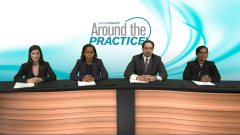
Patient Profile 2: A 79-Year-Old with Multiple Myeloma
The expert panel presents the case of a patient with multiple myeloma and discusses evaluating transplant eligibility in patients with MM.
Episodes in this series

Transcript:
Al-Ola Abdallah, MD: We’re moving to the next case. [This is] a newly diagnosed myeloma 79-year-old male patient with a known history of aortic valve insufficiency, coronary artery disease, dyslipidemia, and diabetes mellitus type-2. He’s complaining of generalized fatigue, went to his primary care physician, found out his WBC [white blood cell] was 4.7. Hemoglobin was low- 7.275 [g/dL]. His kidneys’ creatinine was elevated at 2.4 [mg/dL]. He was known to have a baseline of creatinine 1.3 [mg/dL]. Albumin was 3.0 [g/dL]. His calcium was about 8.1 [mg/dL]. Total protein was elevated to 11 g/dL.
[Those results] prompted that this patient might have multiple myeloma so the workup was done. They did order a skeletal survey and didn’t find any lytic lesions. The serum M [myeloma] protein was done; it was 5.1 g/dL. IgG level was 6244. The β-2 microglobulin was elevated up to 14 [mg/L]. LDH was normal. The serum free kappa light chain was elevated up to 19 mg/dL with a ratio of 28. A bone marrow biopsy was performed to rule in multiple myeloma and it was found that he had 25% monoclonal plasma cells and the FISH [fluorescence in situ hybridization] shows translocation 414 with gain 1q. So, we have high-risk features.
A PET-CT scan was done in regard to that skeletal survey that was negative. That’s why we do the PET-CT scan, it shows numerous markedly hypermetabolic axial and appendicular skeletal lesions as you can see in the slide here. UPEP [urine protein electrophoresis test] was performed and the M-spike showed 18 mg in 24 hours. The patient had performance status of 2.
This patient, is he eligible or not eligible for transplant? We will talk about that. And what treatment do we use? In our case, we used daratumumab-lenalidomide-dexamethasone. He got 6 cycles, and he responded really good to this treatment. So, Nausheen, we have to talk about this. I think this is a common question, whether we look at any trials or not, the first question in newly diagnosed myeloma is: Is the patient eligible or not eligible for transplant? I think that’s reason for us to ask him. Can you give us a comment about the fit and fail and how you decide about transplant eligibility in our institution?
Nausheen Ahmed, MD: That’s a great question. We encourage anyone that, whenever you have a newly diagnosed myeloma patient, always think about transplant. That transplant, it’s kind of beauty is in the eye of the beholder, that the transplanter also assess the patient and see whether the patient is fit or not. So, typically, when I look at a patient who’s being evaluated, of course, you look at the disease, all the disease characteristics, but also the physical fitness. That’s a very important part of the evaluation. We go into the details of the organ function, what does the EF [ejection fraction] and the heart function look like? What’s the pulmonary function look like? What’s the ECOG status? What’s the performance status, the comorbidity burden that they have, what are they dealing with? We [also] try to calculate HCT-CI [hematopoietic cell transplantation-specific comorbidity index] score to see what the comorbidity index is. If they’re really high-risk, then we have to discuss as a group as to whether this patient would be suited for transplant or not.
The question is about age. These trials that looked at transplant, many of them had an age cutoff of 65, but we don’t really use that age cutoff anymore. We transplant patients into their 70s [if they are fit] because there still is a PFS [progression-free survival] benefit, and these patients can still do well with a better quality of life with the transplant. So that’s a major component. Then one other component that we look at is what is their social support like? Are they going to be able to handle transplant and understand what it’s all about? So, we kind of take all of that into consideration when we think about a transplant.
Transcript edited for clarity.
Newsletter
Stay up to date on recent advances in the multidisciplinary approach to cancer.






















































































